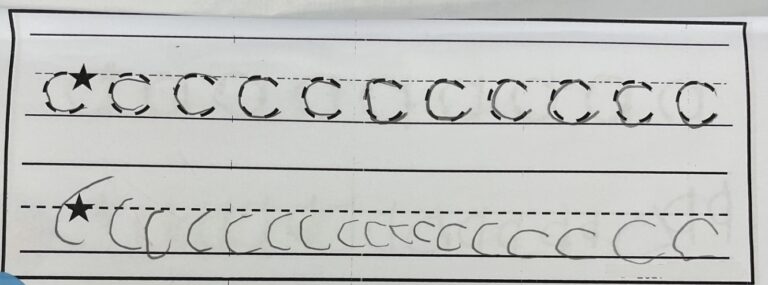For many students, learning to write involves countless drills of isolated letters. The idea? Repetition would solidify the motor skills needed for clear and fluent handwriting. But recent research suggests this approach might not be the most effective.
Handwriting Heroes uses a more strategic way to practice handwriting, one that prioritizes variation over rote repetition. This shift is driven by a deeper understanding of how our brains learn and retain motor skills.
The Drawbacks of Rote Repetition
The traditional method relies on the assumption that frequent repetition strengthens the connections between neurons, making motor skills automatic. While this holds some truth, it isn’t the whole story.
Studies have shown that simply repeating the same movement doesn’t necessarily lead to deeper learning. In fact, it might hinder your ability to adapt to variations. Our brains crave novelty, and encountering slight variations during practice can be more stimulating and lead to better long-term memory.
The theory that repetition alone can cement motor skills into our long-term memory is rooted in the working memory model. This model suggests repetition helps temporarily hold information. However, it overlooks a crucial detail: repetition is most effective when the task is meaningful or challenging enough to trigger significant neurological engagement. The mantra “neurons that fire together wire together” highlights the importance of meaningful practice, but the act of repeating the same letter ad nauseam often lacks the significance required to foster deep learning. Contrary to the belief that “more is better,” studies have shown that simple repetition can lead to a superficial understanding of material, creating an illusion of mastery without the depth of knowledge or skill. This approach can also contribute to negative attitudes towards learning, as students struggle with the diminishing returns of their efforts.
Another challenge is repetition fatigue, where excessive repetition reduces the effectiveness of learning, making it harder to absorb and retain new information. Imagine mindlessly scrolling through social media – your brain gets used to the repetitive stimulation and stops paying close attention. This is similar to what happens with excessive repetition in handwriting practice.
The example below highlights that a kindergarten student, despite having solid visual-motor skills shown by accurate letter tracing, faced challenges with the sheer number of repetitions. After 17 tries at writing the letter ‘c’, none of the attempts met the criteria for correct form and placement on the line, illustrating the impact of repetition fatigue on performance.

The Power of Variation
Research from the University of Southern California makes a strong case for variable practice. Participants practiced arm movements in two ways: constant practice, repeating the same movement, and variable practice, alternating between different movements. The results were enlightening: variable practice not only required participants to engage more deeply but also led to stronger motor memory formation, as indicated by the brain areas activated during recall.
So, if memory is enhanced when we engage in practice that is more challenging and requires one to reconstruct the activity rather than simply repeat it, then practicing a group of letters would more effectively meet the brain’s need for novelty. Benefits of varied practice include:
- Improves Differentiation: Practicing similar letters together hones your ability to differentiate between similar shapes.
- Enhances Memory: Variation keeps practice sessions engaging, promoting deeper processing of letter formations.
- Promotes Adaptability: By encountering variations, you train your brain to adjust motor skills for different letter combinations.
- Sustained Interest: Diversity in practice fights off boredom, prompts more active brain engagement, and encourages persistence.
Strategies for Avoiding Repetition Fatigue
To counter repetition fatigue while maintaining the benefits of necessary repetition, consider the following strategies:
- Group Similar Letters: Practicing letters with common features together can deepen understanding and avoid monotony. This approach challenges and engages learners as they explore letters’ subtle differences in shape and stroke order.
- Incorporate Meaning: Use stories to explain the sequence of movements, adding context and relevance to the practice.
- Segment Practice Sessions: Opt for shorter, varied sessions over longer, monotonous ones to keep focus sharp.
Practice with Purpose
Consistent practice is essential for strengthening neural pathways and developing fluent handwriting. However, it’s crucial to differentiate between mindless repetition and meaningful practice. Mindless repetition can lead to boredom and hinder the development of proper letter formation. Instead, we should focus on practices that encourage active participation and a deeper understanding of letter shapes and stroke order.
Focused practice for 10-15 minutes daily trumps hours of mindless repetition. It’s not about how much you practice, but how you practice. While it can be daunting to change one’s embedded teaching practices, the shift from rote repetition to a dynamic, evidence-based educational methodology will promote deeper learning, better retention, and a more positive approach to handwriting. By embracing purposeful practice, we can transform handwriting from a chore into a skill that unlocks a world of creative expression.
Reference: Winstein, C. J., et al. (2010). Hands-on versus minds-on practice for motor skills learning. Nature Neuroscience, 13(7), 929-935.

